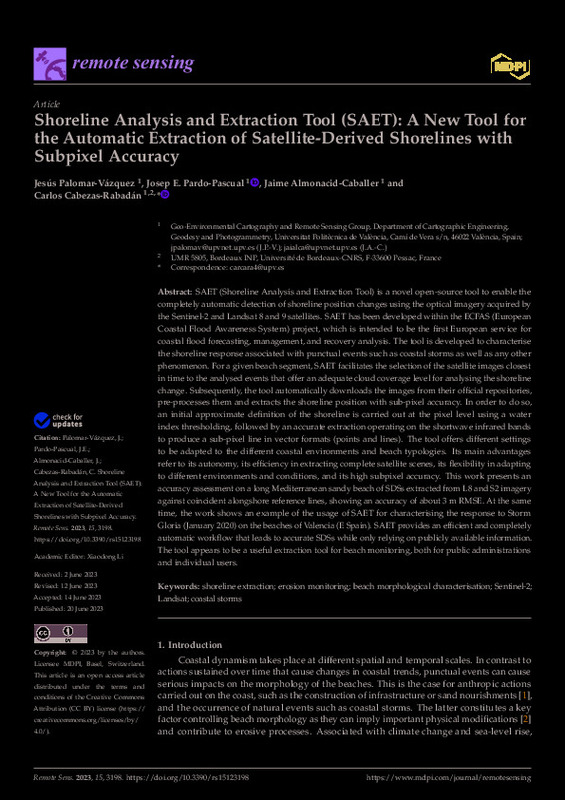|
Resumen:
|
[EN] SAET (Shoreline Analysis and Extraction Tool) is a novel open-source tool to enable the completely automatic detection of shoreline position changes using the optical imagery acquired by the Sentinel-2 and Landsat 8 ...[+]
[EN] SAET (Shoreline Analysis and Extraction Tool) is a novel open-source tool to enable the completely automatic detection of shoreline position changes using the optical imagery acquired by the Sentinel-2 and Landsat 8 and 9 satellites. SAET has been developed within the ECFAS (European Coastal Flood Awareness System) project, which is intended to be the first European service for coastal flood forecasting, management, and recovery analysis. The tool is developed to characterise the shoreline response associated with punctual events such as coastal storms as well as any other phenomenon. For a given beach segment, SAET facilitates the selection of the satellite images closest in time to the analysed events that offer an adequate cloud coverage level for analysing the shoreline change. Subsequently, the tool automatically downloads the images from their official repositories, pre-processes them and extracts the shoreline position with sub-pixel accuracy. In order to do so, an initial approximate definition of the shoreline is carried out at the pixel level using a water index thresholding, followed by an accurate extraction operating on the shortwave infrared bands to produce a sub-pixel line in vector formats (points and lines). The tool offers different settings to be adapted to the different coastal environments and beach typologies. Its main advantages refer to its autonomy, its efficiency in extracting complete satellite scenes, its flexibility in adapting to different environments and conditions, and its high subpixel accuracy. This work presents an accuracy assessment on a long Mediterranean sandy beach of SDSs extracted from L8 and S2 imagery against coincident alongshore reference lines, showing an accuracy of about 3 m RMSE. At the same time, the work shows an example of the usage of SAET for characterising the response to Storm Gloria (January 2020) on the beaches of Valencia (E Spain). SAET provides an efficient and completely automatic workflow that leads to accurate SDSs while only relying on publicly available information. The tool appears to be a useful extraction tool for beach monitoring, both for public administrations and individual users.
[-]
|
|
Agradecimientos:
|
The ECFAS (European Coastal Flood Awareness System) project (https://www.ecfas.eu/) has received funding from the EU H2020 research and innovation programme under Grant Agreement No. 101004211. This research is also supported ...[+]
The ECFAS (European Coastal Flood Awareness System) project (https://www.ecfas.eu/) has received funding from the EU H2020 research and innovation programme under Grant Agreement No. 101004211. This research is also supported by the projects MONOBESAT (PID2019-111435RB-I00)
funded by the Spanish Ministry of Science, Innovation and Universities, and the Margarita Salas contract within the Re-qualification programme by the Ministry of Universities financed by the European Union¿NextGenerationEU and the grant Primeros Proyectos de Investigación (PAID-06-22),
Vicerrectorado de Investigación de la Universitat Politècnica de València (UPV) associated with the corresponding author.
[-]
|









